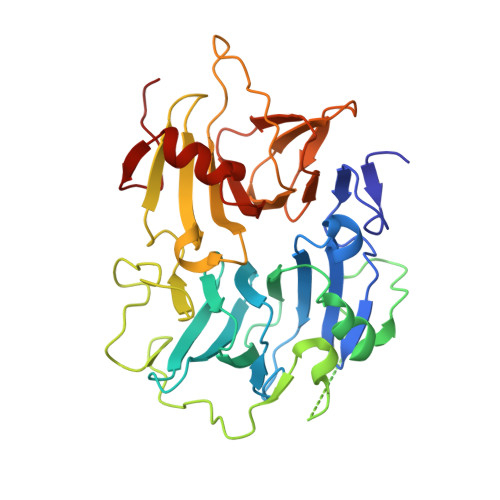Functional Analysis of the Copper-Dependent Quercetin 2,3-Dioxygenase.1.Ligand-Induced Coordination Changes Probed by X-Ray Crystallography: Inhibition, Ordering Effect and Mechanistic Insights
Steiner, R.A., Kooter, I.M., Dijkstra, B.W.(2002) Biochemistry 41: 7955
- PubMed: 12069585
- DOI: https://doi.org/10.1021/bi0159736
- Primary Citation of Related Structures:
1GQG, 1GQH - PubMed Abstract:
The crystal structures of the copper-dependent Aspergillus japonicus quercetin 2,3-dioxygenase (2,3QD) complexed with the inhibitors diethyldithiocarbamate (DDC) and kojic acid (KOJ) are reported at 1.70 and 2.15 A resolution, respectively. Both inhibitors asymmetrically chelate the metal center and assume a common orientation in the active site cleft. Their molecular plane blocks access to the inner portion of the cavity which is lined by the side chains of residues Met51, Thr53, Phe75, Phe114, and Met123 and which is believed to bind the flavonol B-ring of the natural substrate. The binding of the inhibitors brings order into the mixed coordination observed in the native enzyme. DDC and KOJ induce a single conformation of the Glu73 side chain, although in different ways. In the presence of DDC, Glu73 is detached from the copper ion with its carboxylate moiety pointing away from the active site cavity. In contrast, when KOJ is bound, Glu73 ligates the Cu ion through its O(epsilon)(1) atom with a monodentate geometry. Compared to the native coordinating conformation, this conformation is approximately 90 degrees rotated about the chi(3) angle. This latter Glu73 conformation is compatible with the presence of a bound substrate.
Organizational Affiliation:
Laboratory of Biophysical Chemistry, Department of Chemistry, University of Groningen, Nijenborgh 4, 9747 AG Groningen, The Netherlands.



















